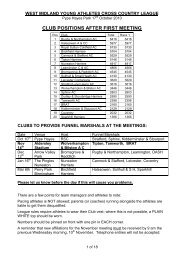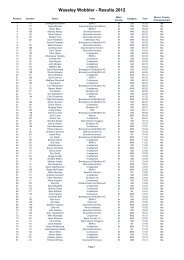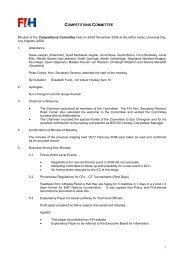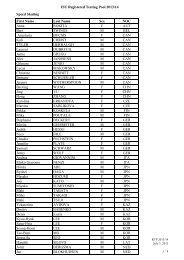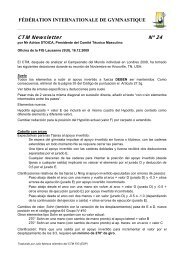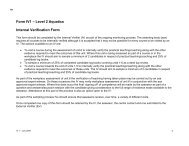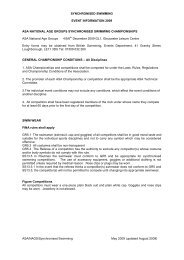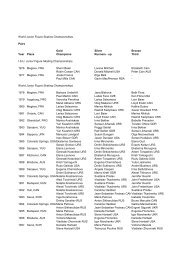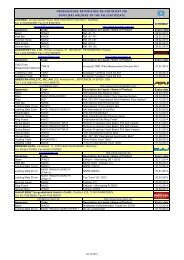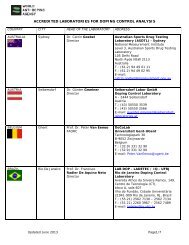SWIMMING OFFICIALS SWIMMING OFFICIALS - F.i.g.
SWIMMING OFFICIALS SWIMMING OFFICIALS - F.i.g.
SWIMMING OFFICIALS SWIMMING OFFICIALS - F.i.g.
Create successful ePaper yourself
Turn your PDF publications into a flip-book with our unique Google optimized e-Paper software.
NEWSAugust 2005<strong>SWIMMING</strong> <strong>OFFICIALS</strong>A two-way exchange of information with the ASA Swimming Officials CommitteeMany of you will be aware thatOctober 1st not only sees theimplementation of the new Regionalstructure but also the incorporation ofFINA Rules into the ASA RacingTechnical Rules.This date was decided by ASA Committeeto facilitate the inclusion of any changesmade by FINA at their Congress in July2005. FINA consider rule changes everyfour years and changes made to theirSwimming Rules would have beenconsidered by ASA Committee foradoption. Now that FINA Rules have beenincorporated into ASA Racing TechnicalRules, changes made by FINA willautomatically be adopted.This is not something new for the ASA.Water Polo and Diving have operated thisway for some years.This SON is being distributed with a copyof the Extracts of ASA Laws and ASATechnical Rules which includes the relevantFINA Rules for reference. The complete setof FINA Rules can be found atwww.fina.org.So, how will this change affect the waywe all operate on the pool deck? Notmuch is the answer as the old ASA RacingTechnical Rules were very closely alignedwith FINA Rules, particularly the strokerules which were nearly word for word thesame. FINA have made some changes tothese stroke rules this year and these willbe discussed later.Competitions in England can continue tobe held under the ASA Racing TechnicalRules, just as now, as these Rules nowincorporate FINA Rules. If a competition isheld under FINA Rules, none of theadditional provisions made in ASATechnical Rules 5xx would apply.FINA Rules are less restrictive than our oldRacing Technical Rules as parts specificallyrefer to high level competitions and willnot be applicable to most competitionsheld in England. An example of this is theminimum number of Officials at acompetition. FINA only indicate thenumber required at Olympic, World Cup orWorld Championships. However, in someother areas they are more restrictive thanwe are used to. Under FINA Rules theswimmer must start with a dive, lap cardsmust be positioned at the turning end, arejust two examples.In the 2004 annual Refereeexaminations, the following Officialssuccessfully became registeredRefereesSue BarkerPiers CardonLiz ChristianMichael CooperChristine CowleyIan DaveyRobert DrageJim DruryPatricia GabbitasDiane GambleBill GlendinningPeter GonsalvesStephen HennellStuart HighfieldPauline HoggMichael JonesLyn KayDavid McRobertsMuriel MoffetKeith MundayRoger PerrellRichard RobertsMargaret RobertsJacqueline SandbachRichard StarlingRoger StricklandStuart TawnJohn TowleSteven TurnerJohn WhalingGary WhittleShirley WigleyCongratulations !There were also 33 passesIn the Race Results Examination143 Starter320 Judge&863 TimekeeperSuccessesThe first is easily resolved by ASA TechnicalRule 501 “...ASA Health and Safetyguidelines take precedence...” so where aswimmer has not achieved the standard ofthe ASA Competitive Start Award, they arepermitted to start in the water. The secondis addressed by the “ASA Guidance to FINARules” appendix which gives appropriateguidance to Promoters and Referees in theapplication of FINA Rules in differingcompetition conditions. More on this newguidance to FINA Rules later.Let’s start by identifying some aspects thathave changed by incorporating FINA Rules.Some of these may be welcomed by you!There is now no requirement to warnswimmers they have two lengths + 5m toswim in individual 400m Freestyle races,only in 800m and 1500m Freestyle races.(SW 2.5.4 refers) As a reminder, if lap cardsare being used, then the warning signal isrequired.If you’ve just looked at the SW referenceabove, you would have seen this duty isundertaken by an Inspector of Turns (IoT).In old ASA speak, this would be a TurnJudge, however, we should endeavour touse the new names to avoid any confusion.Turn Judge becomes an Inspector of Turns(IoT), Stroke Judge is Judge of Stroke (JoS),Placing Judges are Finish Judges and aCompetitor Steward is a Clerk of Course(CoC). The other names remain the same.It’s also worth noting here, that if acompetition is fortunate enough to havethree Timekeepers allocated to each lane,Finish Judges are not required as final placeand time is determined by time. (SW 2.7.1refers).Swimmers are no longer required toremain in their lane until released by anOfficial. SW 10.13 states “Any swimmerhaving finished his race, or his distance in arelay event, must leave the pool as soon aspossible without obstructing any otherswimmer who has not yet finished his race.Otherwise the swimmer committing thefault, or his relay team, shall bedisqualified.” There may be occasionswhere this is not desirable e.g. over the topstarts. Promoter’s conditions andannouncements should make this variationknown. The Referee may decide that it issafer to have the swimmers remain in theirlanes until being released. If this is the case
the Referee should ensure all swimmers are informed.The ASA Guidance to FINA Rules appendix in the Extracts isdesigned to offer practical guidance in running a competition.Some of these are worthy of note here.SW 1 Management of CompetitionsFINA only provide the minimum number of Officials required forOlympic Games, World Championships and Word Cups. (SW1.2)This guidance applies to competitions below this level.SW 2 OfficialsAs previously mentioned, FINA position lap cards at the turningend of the pool. This requires an IoT to be positioned on everylane and is considered impractical for many of our competitions.The Promoter should have the discretion to place lap cards at thefinish end of the pool and if an IoT is not allocated to every lane,the lane Timekeeper should operate these cards and give thewarning signal when required. (SW 2.5.3 & SW 2.5.4.)SW 3 Seeding of Heats, Semi Finals and FinalProvision has been made for the case where swimmers from thesame heat have equal times but different places when usingmanual times. To determine progression to the next round, theplacing should be used.SW 4 The StartSwimmers who have not reached the standard of the ASACompetitive Start Award are permitted to start from the pool deckor in the water.SW 10 The RaceFoulingPreviously, the Referee had the option of allowing the fouledswimmer progression to the next round. This progression can nowonly be achieved through a reswim. (SW 10.14)Relay EventsSwimmers starting in the water must maintain hand contact withthe starting place until the preceding swimmer touches.Team Relay members and order of competing must benominated before the event unless the Promoters conditions stateotherwise but may be changed between rounds.SW 11 TimingThe guidance provided in this section is primarily what to do whenthings go wrong with the AOE. The significant change being thatthe Referee uses all available information to determine the result.Previously the Semi-AOE time had to be used if it was available. Ifnone of the manual times, not forgetting that Semi-AOE is amanual time, are suitable, then the Referee can award the sametime as the swimmer that causes the conflict.The Referee can now use all available information to reach adecision and decide which information may be more accurate. Asan example, there were three Timekeepers on a lane but only oneof them operated the Semi-AOE button. If the AOE failed on thislane, it would be appropriate to place the swimmer using the timefrom the three Timekeepers and not the Semi-AOE.FINA Rule Changes 2005You will have noticed that there is no guidance given for any ofthe Stroke rules, SW 5 through 9. Adopting FINA Rules has notchanged anything here, however, FINA have recently agreed somechanges to these which now need to be mentioned. The FINARules printed in the Extracts reflect these changes. For clarity, thewording is shown below indicating the changes from the 2002 -2005 FINA Rules. (bold underline = new, strikethrough = deleted)SW 6.1Prior to the starting signal, the swimmers shall line up in the waterfacing the starting end, with both hands holding the startinggrips. The feet, including the toes, shall be under the surface ofthe water. Standing in or on the gutter or bending the toes overthe lip of the gutter is prohibited.The requirement of toes being under the surface of the waterhas been removed.SW 6.3Some part of the swimmer must break the surface of the waterthroughout the race. It shall be is permissible for the swimmer tobe completely submerged during the turn, at the finish and for adistance of not more than 15 metres after the start and each turn.By that point the head must have broken the surface.No change to intent.SW 6.4When executing the turn there must be a touch of the wallwith some part of the swimmer’s body. During the turn theshoulders may be turned over the vertical to the breast afterwhich a continuous single arm pull or a continuous simultaneousdouble arm pull may be used to initiate the turn. Once the bodyhas left the position on the back, any kick or arm pull must be partof the continuous turning action. The swimmer must havereturned to the position on the back upon leaving the wall. Whenexecuting the turn there must be a touch of the wall with somepart of the swimmer’s body.No change to the current interpretation...a ‘glide’ is notpermitted. FINA believe this change will simplify the rule and
make it less open to interpretation.SW 6.5Upon the finish of the race the swimmer must touch the wall whileon the back. The body may be submerged at the touch.Submerged at the finish included in SW 6.3. FINA consider thefinish to be the touch.SW 7.1From the beginning of the first arm stroke after the start and aftereach turn, the body shall be kept on the breast. It is not permittedto roll onto the back at any time. Throughout the race thestroke cycle must be one arm stroke and one leg kick in thatorder.Addition moved from SW 7.7.SW 7.4During each complete cycle, some part of the swimmer’shead shall break the surface of the water. After the startand after each turn, the swimmer may take one arm strokecompletely back to the legs. The head must break the surfaceof the water before the hands turn inward at the widest part ofthe second stroke. A single downward dolphin kick followedby a breaststroke kick is permitted while whollysubmerged. Following which, all movements of the legs shallbe simultaneous and in the same horizontal plane withoutalternating movement.First addition moved from SW 7.7.Second addition is new. Swimmers are now permitted a singledownward dolphin kick after the start or turn removing the issueof whether the kick was a permitted undulation.SW 7.5The feet must be turned outwards during the propulsive part ofthe kick. A scissors, flutter or downward dolphin kick is notpermitted except as in SW 7.4. Breaking the surface of thewater with the feet is allowed unless followed by a downwarddolphin kick. Accommodating the change in SW 7.4.SW 7.7During each complete cycle of one arm stroke and one leg kick, inthat order, some part of the swimmer’s head shall break thesurface of the water, except that after the start and after each turnthe swimmer may take one arm stroke completely back to the legsand one leg kick while wholly submerged. The head must breakthe surface of the water before the hands turn inward at thewidest part of the second stroke. The requirements of SW 7.7 arenow addressed elsewhere.SW 8.3All up and down movements of the legs must be simultaneous.The position of the legs or the feet need not be on the same level,but they shall not alternate in relation to each other. Abreaststroke kicking movement is not permitted.No change to intent.SW 10.10In relay events, the team of a swimmer whose feet lose touch withthe starting platform before the preceding team-mate touches thewall shall be disqualified. Unless the swimmer in default returns tothe original starting point at the wall, but it shall not be necessaryto return to the starting platform.No second chance now permitted.So there we have it. We expect the changes being made willgenerate several questions/clarifications and the SOC will addressthese by way of a FAQ on the Officials pages atwww.britishswimming.org. So look there first and see if yourquestion has already been answered.Disability SwimmingOver the last couple of years, swimmers with a disability have beenintegrated into many able bodied events and this processcontinues.To support the Officiating of these events, ASA Disability andDistricts have funded fifteen volunteers to participate in theInternational Paralympic Committee Swimming (IPC Swimming)Officials training programme. This training requires thecompletion of an on-line course and attendance of a seminartogether with practical experience at Disability Competitions.Having completed this training these Officials are now certifiedas an ASA Disability Swimming Official and should be utilized as aregular deck Official at events where swimmers with a disabilityparticipate. If the Referee wishes to clarify any Disability rules thatmay apply to swimmers, these Officials can provide the guidance.Officials are located in nearly every Region and the number willincrease as ASA Disability delivers a National version of thetraining.The following Officials are also, ASA DisabilitySwimming OfficialsSue Barker, Rodney Briggs, Elizabeth Christian, Alan Day, LynneElliott, Hilary Essam, David Harman, Joan Hawkins, BobOuttram, Susan Prasad, Biddy Rowe, Kaye Savoury, Sally Stow,Tony Ward, Janice Whittle



